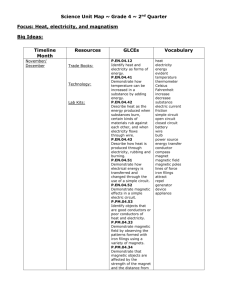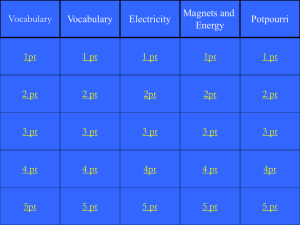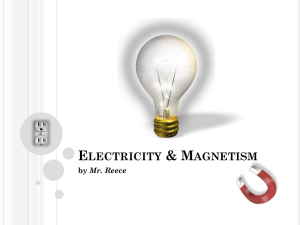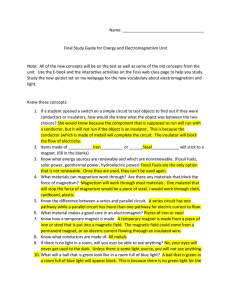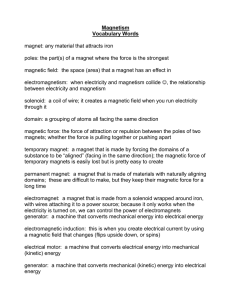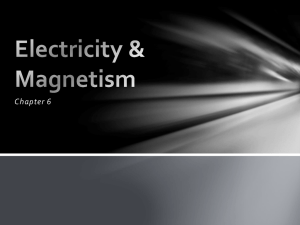Electricity and Magnetism Study Guide Answer Key VOCABULARY
advertisement
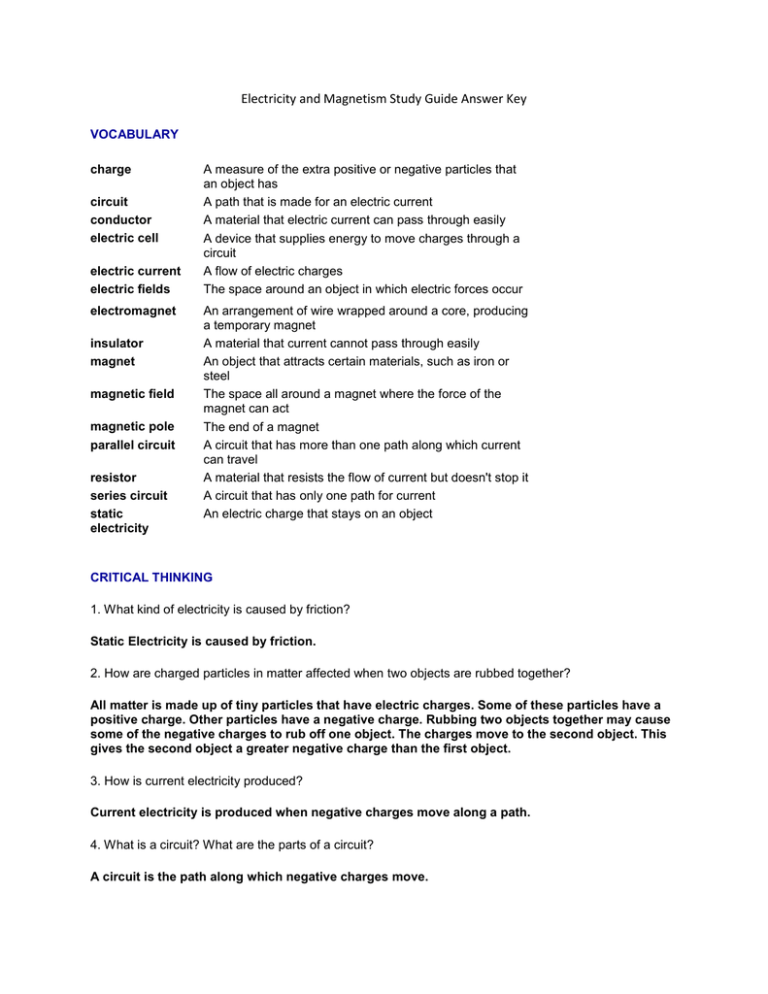
Electricity and Magnetism Study Guide Answer Key VOCABULARY charge circuit conductor electric cell electric current electric fields electromagnet insulator magnet magnetic field magnetic pole parallel circuit resistor series circuit static electricity A measure of the extra positive or negative particles that an object has A path that is made for an electric current A material that electric current can pass through easily A device that supplies energy to move charges through a circuit A flow of electric charges The space around an object in which electric forces occur An arrangement of wire wrapped around a core, producing a temporary magnet A material that current cannot pass through easily An object that attracts certain materials, such as iron or steel The space all around a magnet where the force of the magnet can act The end of a magnet A circuit that has more than one path along which current can travel A material that resists the flow of current but doesn't stop it A circuit that has only one path for current An electric charge that stays on an object CRITICAL THINKING 1. What kind of electricity is caused by friction? Static Electricity is caused by friction. 2. How are charged particles in matter affected when two objects are rubbed together? All matter is made up of tiny particles that have electric charges. Some of these particles have a positive charge. Other particles have a negative charge. Rubbing two objects together may cause some of the negative charges to rub off one object. The charges move to the second object. This gives the second object a greater negative charge than the first object. 3. How is current electricity produced? Current electricity is produced when negative charges move along a path. 4. What is a circuit? What are the parts of a circuit? A circuit is the path along which negative charges move. There are four parts to a circuit: (1) There is a source of electricity Example: A battery (2) There is a path along which charges can move. Example: A wire (3) There is a switch that opens and closes the circuit. Example: A knife switch (4) There is some object that uses the electricity. Example: A light bulb 5. Explain the difference between a complete circuit and an incomplete circuit. When a switch is closed or turned on, the path of electricity is complete. The charges move. A circuit whose path is complete is called a complete circuit. When the switch is open, or turned off, the path is broken. The movement of charges stops. The path is incomplete. A circuit whose path is incomplete is called an incomplete circuit. 6. Explain how electricity is produced in a flashlight. A dry cell battery is the source of electricity in a flashlight. 7. What are the three ways to make electricity? Electricity can be made from chemical energy in dry cell batteries and wet cell batteries, and from mechanical energy in generators. 8. What would show the magnetic field of a magnet? A magnetic field may can be seen when iron filings are sprinkled near a magnet. The iron filings form a pattern of lines. These lines are called lines of force. Lines of force show where the magnetic field is and what it looks like. 9. Explain the difference between the two poles of a magnet. The ends of a magnet are called the poles. A magnetic field is strongest at the poles. A magnet has two poles - a north pole and a south pole. The poles are equal in strength. The north pole of one magnet attracts the south pole of another magnet. The south pole of one magnet attracts the north pole of another magnet. But the north pole of one magnet repels, or pushes away, the north pole of another magnet. In the same way, the south pole of one magnet repels the south pole of a second magnet. 10. How are particles in magnetized iron different from those in unmagnetized iron? Most magnets are made of iron. The particles that make up iron are like tiny magnets. In a normal piece of iron the particles are all mixed up. They point in different directions. In a magnetized piece of iron the particles point in the same direction. 11. How is magnetism used to produce electricity? Magnetism can be used to produce electricity. This can be done by moving a magnet through a coil of wire. Electricity is produces as long as the magnet moves through the coil. A generator produces electricity this way. 12. What are some uses of electromagnets? Electromagnets are often used in scrap yards to lift metal and move it. Many electromagnets are strong enough to lift heavy objects, such as cars. Electromagnets are also used in telephones. 13. In what ways are electricity and magnetism alike? Electricity and magnetism both produce a force that can pull or push things without touching them. They both have opposite states: electricity has positive and negative, and magnetism has north-seeking and south-seeking. In both, opposite states attract and same states repel. 14. What will happen if you put a compass next to an electromagnet that is switched on? The compass needle will turn because an electromagnet produces a magnetic field. The magnetized compass needle will move to line up with the field lines. Series and Parallel Circuits Magnets
